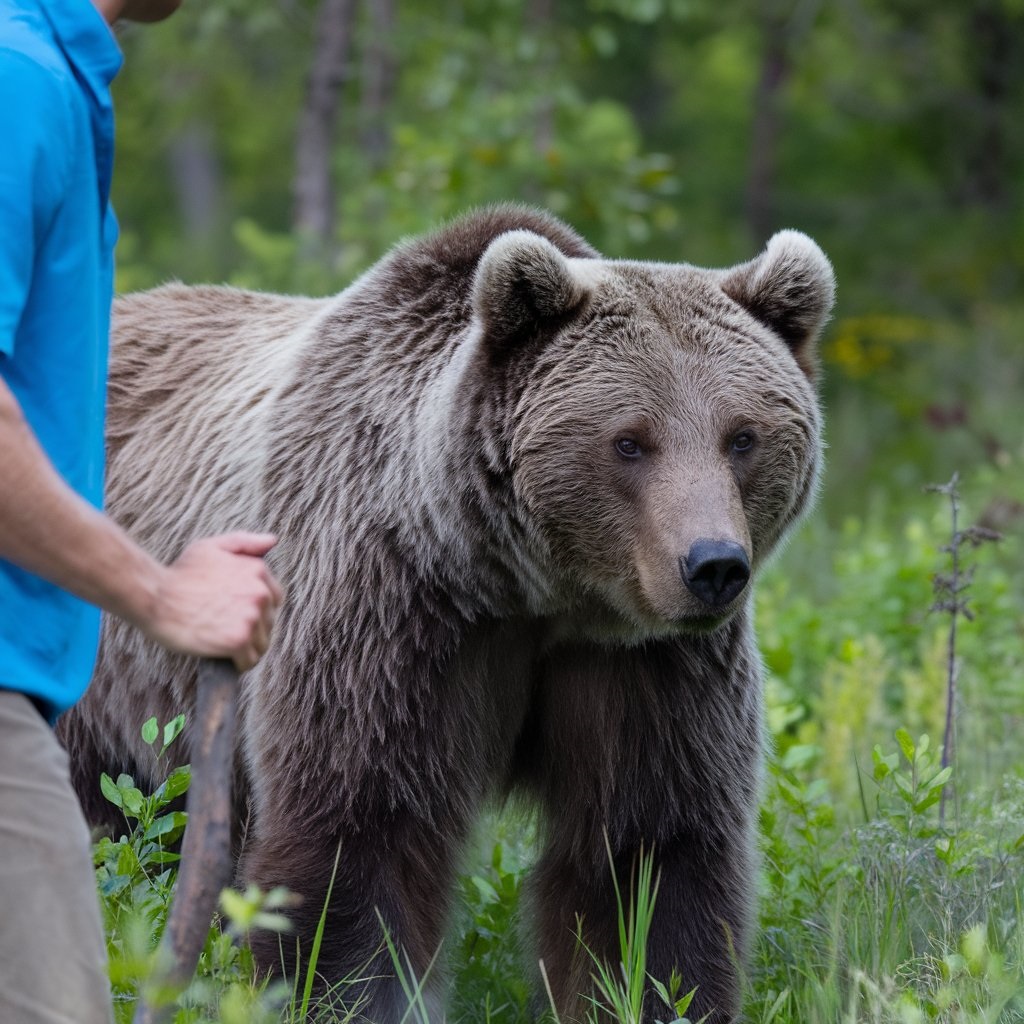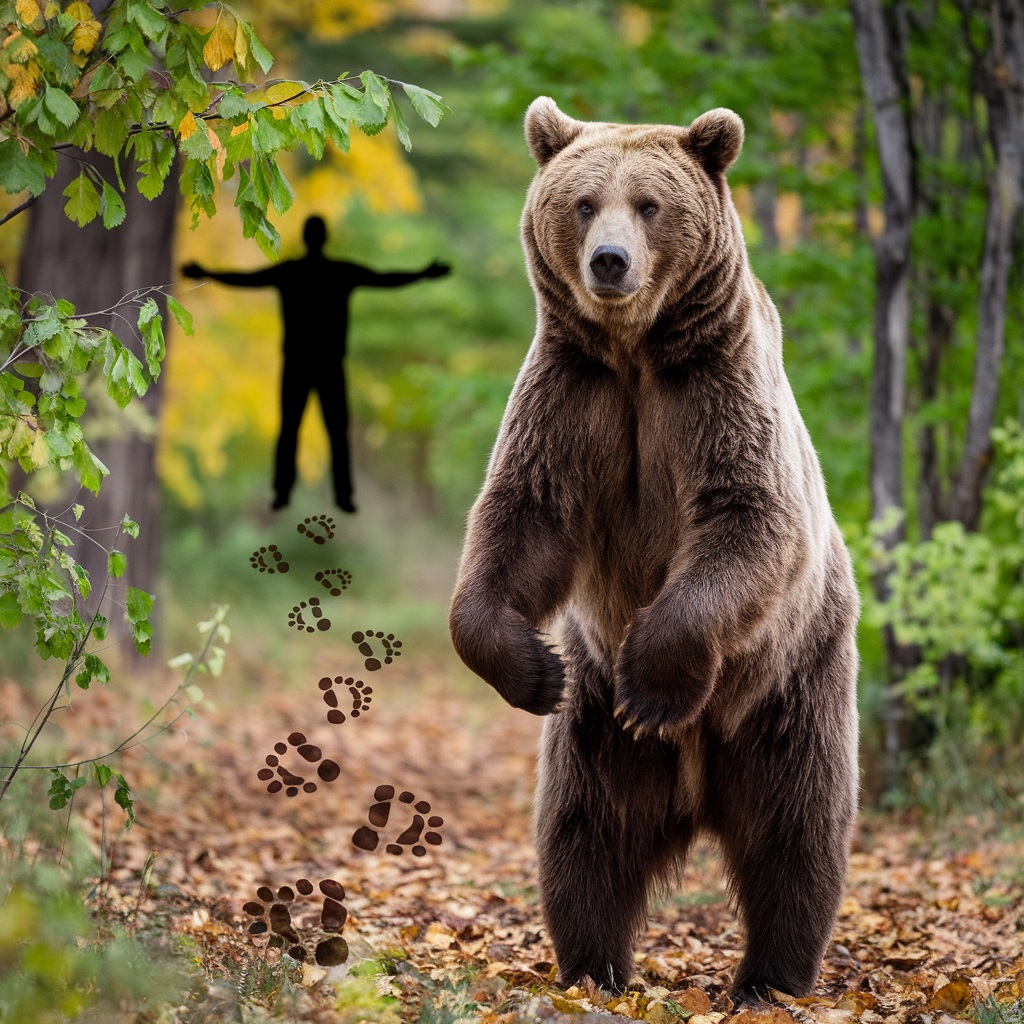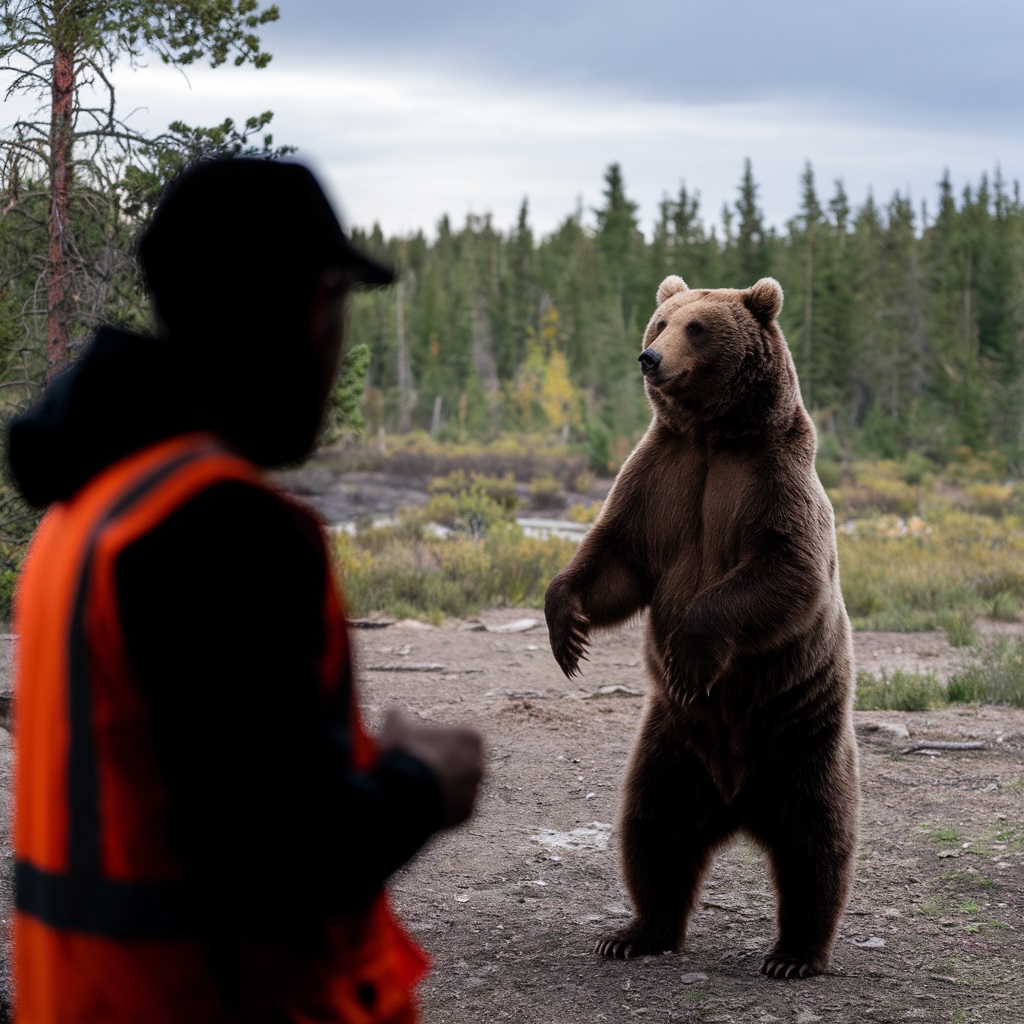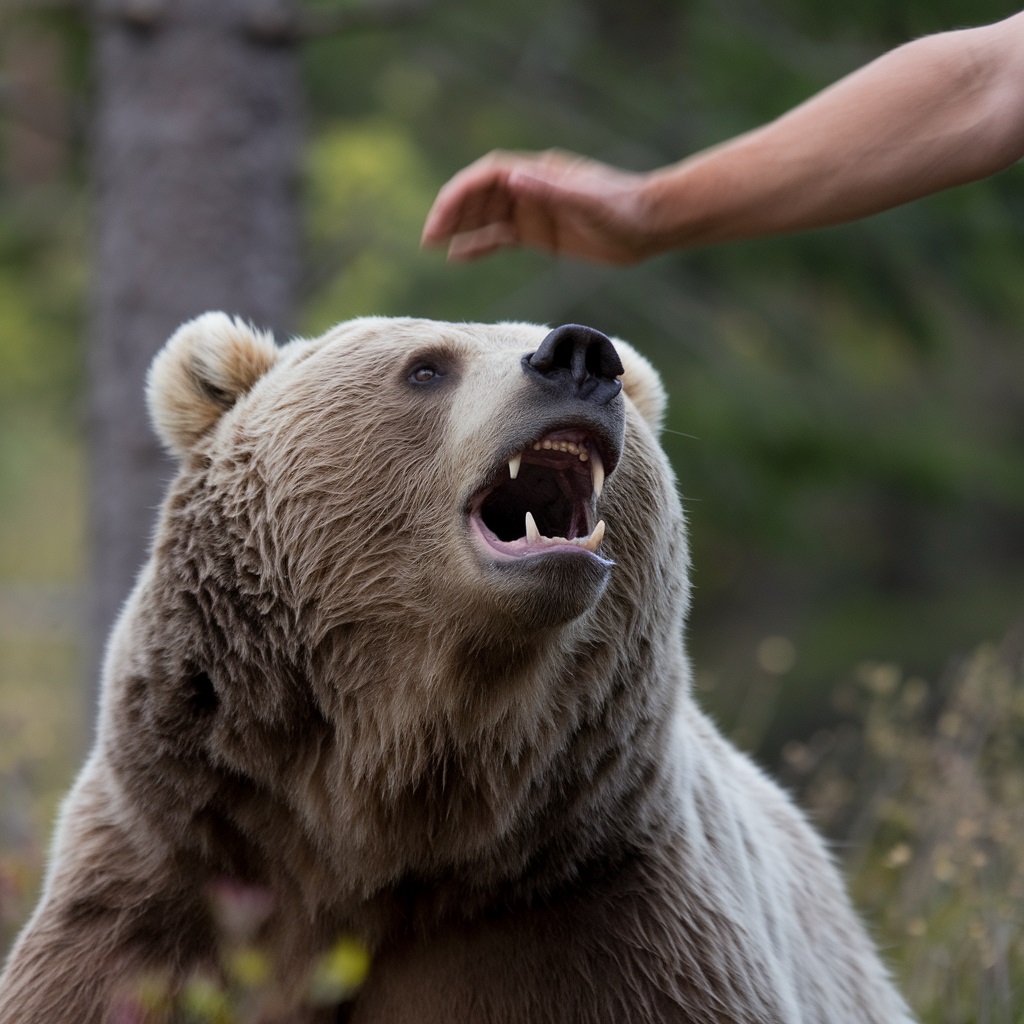The question, “Do bears attack humans?”, often sparks fear and curiosity, particularly among those who live or venture into bear habitats. While bears are undeniably powerful creatures, it’s important to understand that they are not typically inclined to attack humans. Most bears, including the grizzly bear, black bear, and polar bear, will generally avoid human encounters. However, when certain conditions arise, such as food scarcity or surprise encounters, bear attacks can occur.
Understanding the behaviors behind these rare attacks, along with how to stay safe in bear country, is crucial for anyone hiking, camping, or living near bear habitats. This comprehensive guide will help you navigate bear safety, clarify the risks, and provide effective strategies to avoid potential encounters with these fascinating animals.
Here’s a table that summarizes key facts and figures related to bear attacks and bear safety from the article:
| Topic | Fact/Figure |
|---|---|
| Bear Species Involved in Attacks | Grizzly Bears, Black Bears, Polar Bears |
| Common Causes of Bear Attacks | Surprising a bear, human encroachment, food attractants, protecting young or food sources |
| Bear Attack Frequency | Roughly 30-40 attacks occur annually in North America (Grizzly and Black Bears) |
| Percentage of Fatal Bear Attacks | Approximately 1 in 3 bear attacks are fatal. Grizzly Bear attacks are most likely to result in fatal injuries. |
| Bear Encounter Statistics | Over 60% of bear encounters occur when people are hiking or camping in bear habitats |
| Bear Spray Effectiveness | 90% effective in deterring bear attacks when used properly |
| Bear-Proof Containers | Recommended to store food in bear-proof containers or hang food 10 feet above ground and 4 feet from tree trunk |
| Proper Distance for Food Storage | Store food at least 100 yards away from sleeping areas and campsite |
| Bears’ Feeding Habits | Bears are omnivores but are opportunistic feeders, often scavenging from human campsites or trash, especially in food-scarce environments |
| Grizzly Bear Aggression | Most likely to display maternal aggression or attack when surprised or threatened while protecting food or cubs |
| Black Bear Aggression | Typically less aggressive but may attack if threatened, startled, or in competition for food |
| Polar Bear Habitats | Found primarily in Arctic Regions, including Alaska, Canada, Greenland, Norway, and parts of Russia, with encounters increasing due to climate change |
| Bear Attack Prevention Measures | Bear-proof fencing, proper food storage, and noise-making (like clapping or talking loudly) help avoid encounters |
Types of Bears and Their Habitats
Overview of Bear Species
The bear family (Ursidae) includes eight species, each occupying different types of habitats across the globe. Understanding the types of bears in various regions is the first step in mitigating risks, especially when you’re hiking or camping in bear country. The three most common bear species that interact with humans in North America are:
- Grizzly Bears (Ursus arctos)
Grizzly bears are one of the largest and most powerful bear species. They are primarily found in North America, particularly in Alaska, Canada, and the northwestern United States. Their aggressive nature, especially when protecting their young or food sources, means they pose a higher risk for human encounters. Grizzly bear aggression often stems from maternal instincts and territorial defense. - Black Bears (Ursus americanus)
Black bears are the most widespread bear species in North America. Found throughout the U.S., Canada, and parts of Mexico, they are more adaptable and often live in forests, swamps, and even urban environments. While they are generally less aggressive than grizzlies, black bears can still become a threat when surprised, threatened, or when they feel cornered. - Polar Bears (Ursus maritimus)
Polar bears are the largest bear species, and they predominantly inhabit the Arctic regions, including Alaska, Canada, Greenland, and parts of Russia. Due to climate change and melting ice, polar bears are increasingly coming into contact with human settlements. These bears primarily hunt seals, but in areas with food scarcity, they may target human settlements, especially in the quest for food.

Geographic Distribution of Bear Species
Bears are distributed across various regions, with each species occupying different environmental niches. The geographic distribution of bear species can impact the likelihood of human encounters, particularly as urban expansion pushes human activity into traditionally remote bear habitats.
Here’s a quick breakdown of where you might encounter each bear species:
| Bear Species | Geographic Range | Habitat Type |
|---|---|---|
| Grizzly Bears | Alaska, western Canada, northwestern U.S. | Forests, tundra, alpine regions |
| Black Bears | North America (U.S., Canada), parts of Europe and Asia | Forests, swamps, urban areas |
| Polar Bears | Arctic regions (Alaska, Canada, Greenland, Russia) | Arctic sea ice, coastal areas |
| Andean Bears | Andes Mountains in South America | Cloud forests |
| Sloth Bears | India, Sri Lanka | Tropical forests |
Differences in Bear Behavior
The behavior of bears can vary significantly between species. Some are more likely to show aggression, while others tend to be more passive. Understanding these differences is key to reducing your risk of a bear encounter.
- Grizzly Bears: Known for their aggressive defense of their territory, food, and young, grizzlies are more prone to aggressive encounters than other species. These bears will not hesitate to defend their cubs or food sources, which can lead to dangerous situations.
- Black Bears: Typically less aggressive, black bears tend to avoid human contact. However, they can become aggressive when startled, threatened, or in the presence of food. Black bear behavior is more opportunistic when it comes to scavenging human food.
- Polar Bears: Polar bears are primarily carnivorous and are more likely to approach humans when food sources are scarce. Their encounters with humans can be dangerous, especially in regions where they are forced into closer contact with human settlements due to climate change.
Understanding Bear Aggression
Myths vs. Facts About Bear Aggression
When it comes to bear attacks, there are several myths that can skew perceptions. Many people believe that bears are naturally aggressive, but this is far from the truth. In fact, bear aggression is often a reaction to being threatened, surprised, or encountering food sources. Let’s address some common myths:
- Myth: Bears are naturally aggressive towards humans.
Fact: Bears typically avoid human interaction. Most attacks occur because a bear feels threatened, is protecting its cubs or food, or is startled at close range. - Myth: A bear that charges is definitely attacking.
Fact: Bears often engage in bluff charging—they may run towards a person and then stop short. This is more common with grizzly bears. It’s a way for the bear to assert dominance without actually attacking. - Myth: Bears only attack in defense of their cubs or food.
Fact: While maternal aggression and food defense are common reasons for bear attacks, bears may also attack when they feel surprised or cornered.
Common Reasons for Bear Attacks
There are several primary causes behind bear attacks on humans. Understanding these reasons can help you reduce the risk of an encounter.
- Human Encroachment on Bear Habitats: As humans expand into bear territories, bear-human encounters become more likely. Bears are drawn to human settlements by food sources, whether from improperly stored food, garbage, or livestock. The rise of urban expansion into wild areas increases the chances of conflict.
- Bears Protecting Their Young or Food Sources: Maternal aggression is common in grizzly bears. Mother bears are extremely protective of their cubs. Similarly, bears will defend food sources (e.g., a carcass or a food cache) if they feel threatened.
- Surprising a Bear at Close Range: Bears have poor eyesight, so they often rely on their sense of smell and hearing. If you inadvertently surprise a bear at close range, it might react aggressively. This is particularly true if the bear is startled or feels trapped.
- Food Attractants and Improper Storage: Bears are opportunistic feeders and will scavenge for food. Improperly stored food, trash, or even toiletries (scented items like deodorant or toothpaste) can attract bears. Food attractants significantly increase the risk of bear encounters.

Are You at Risk? Understanding Bear Attack Statistics
Frequency of Bear Attacks Globally
While bear attacks on humans are sensationalized in the media, statistically, they remain rare. According to wildlife agencies, the number of injuries from bear encounters averages around 50-60 annually in North America. The number of fatal bear attacks is much lower, but they still occur.
Here’s a breakdown of bear attack statistics for different regions:
| Region | Grizzly Bear Attacks | Black Bear Attacks | Polar Bear Attacks |
|---|---|---|---|
| North America | 10-20 annually | 30-40 annually | Rare, increasing |
| Arctic Regions | Rare | Rare | 5-10 annually |
| Europe & Asia | Low | Low | Rare |
Bear Species and Aggression
Different bear species exhibit varying levels of aggression toward humans. Grizzly bears, for instance, are more likely to display maternal aggression and will aggressively defend their cubs and food. Black bears, on the other hand, tend to be more passive but can still become dangerous if they feel threatened or hungry. Polar bears may be more prone to attacking humans in regions where their traditional food sources are disappearing.
How to Prevent Bear Attacks: Bear Safety Tips
General Safety Tips for Hiking and Camping
Hiking and camping in bear country requires a proactive approach to safety. Follow these tips to minimize your risk:
- Travel in Groups: Bears are more likely to avoid larger groups of people. Hiking in pairs or groups increases your chances of scaring off bears with noise and reduces the likelihood of a surprise encounter.
- Make Noise: Bears have poor eyesight but excellent hearing and a strong sense of smell. When hiking or camping, making noise (talking, clapping, singing, or using a bear bell) alerts bears to your presence, reducing the chances of surprising one.
- Be Aware of Bear Signs: Keep an eye out for bear tracks, scat, claw marks, and overturned rocks. These signs may indicate bear activity in the area, giving you a heads-up to proceed with caution.
Food Storage Techniques
Improper food storage is a major contributor to bear encounters. Bear-proof containers and proper food storage are essential to keeping bears at bay:
- Bear-Proof Containers: Use bear-proof containers to store food and any scented items (such as toothpaste, deodorant, or soap). These containers are designed to withstand bear attempts to break into them.
- Hanging Food: If you don’t have bear-proof containers, hang your food at least 10 feet off the ground and 4 feet away from tree trunks. This makes it much harder for bears to access.
- Bear-Resistant Trash Cans: Store trash in bear-resistant trash cans to avoid attracting bears. These cans are specially designed to prevent bears from rummaging through your garbage.

What to Do During a Bear Encounter
Defensive vs. Non-Defensive Responses
When encountering a bear, how you react will depend on the bear’s behavior:
- Defensive Behavior: Bears will exhibit defensive behavior when protecting their cubs or food. If a bear displays defensive signs (such
as making noise, standing tall, or showing its teeth), remain calm, avoid eye contact, and slowly back away.
- Non-Defensive Behavior: If a bear is curious or simply startled, it may approach. In this case, you should back away slowly, avoid making sudden movements, and never run.
Using Bear Spray Effectively
Bear spray is one of the most effective ways to deter a bear from attacking. When used properly, bear spray can stop a bear from charging within seconds:
- Aim for the Bear’s Face: Target the bear’s face, particularly its eyes and nose, to deter the bear.
- Deploy Early: Use bear spray when the bear is still 30 feet away, giving you time to stop the bear before it gets too close.
- Stay Calm: Despite the adrenaline, it’s important to remain calm and deploy the spray confidently.

FAQs
1. How likely would a bear attack a human?
The chances of a bear attacking a human are extremely low, with the odds being approximately 1 in 2.1 million. Most bear encounters are nonviolent and do not lead to injury.
2. Are bears friendly to humans?
Bears are generally not aggressive toward humans and prefer to avoid us unless they are provoked or need to be near a food source.
3. What makes a bear attack a human?
Bear attacks are typically defensive, triggered by a perceived threat to their young or food, such as a carcass. Sudden encounters can also provoke attacks.
4. What do you do if a bear is chasing you?
If a bear is chasing you, avoid running as it may provoke a chase. Instead, make noise, back away slowly, and avoid eye contact.
5. What is the most aggressive bear?
Grizzly and polar bears are considered the most aggressive, with some brown and black bears also being capable of attacking humans, particularly when threatened.
6. Can a human beat a bear in a fight?
Humans are no match for a bear’s strength and size, with no real chance of winning in a fight against such a powerful animal.
7. Is it OK to pet a bear?
While domesticated animals may be petted, it is highly discouraged to attempt petting wild bears, as their behavior can be unpredictable and dangerous.
8. Why are bears so aggressive?
Bears are usually only aggressive when defending themselves, their cubs, or their territory. Most attacks happen when they feel threatened.
9. Are lions friendly to humans?
Lions are not naturally friendly but may tolerate humans if treated respectfully. They can become dangerous if hungry or desperate.
10. Which bear has killed the most humans?
Black bears are responsible for the most human fatalities, with over 60 deaths since 1900, though this is more due to their population size than aggressiveness.
11. How fast can a bear run?
Grizzly bears can run at speeds up to 40 mph, covering significant ground in seconds, making them much faster than humans.
12. Has anyone survived a grizzly bear attack?
There have been survivors of grizzly bear attacks, such as Shayne Burke, who used bear spray and survival instincts to survive a close encounter.
13. Should you play dead if a bear is chasing you?
If attacked by a grizzly bear, playing dead by lying flat on your stomach with your hands behind your neck is the recommended survival tactic.
14. What are the three bear rules?
The three essential rules for bear encounters are: “If it’s black, fight back; if it’s brown, lie down; if it’s white, say good night.”
15. What to do after killing a bear?
After killing a bear, it’s advised to freeze or can the meat quickly, as it tends to become stronger in flavor the longer it’s stored.
16. Is a bear more aggressive than a lion?
Bears are generally more solitary and less aggressive unless provoked, while lions are social animals that hunt in packs, using strategy and teamwork.
17. Why are bears afraid of cats?
Bears avoid cats, likely due to the risk of being attacked by larger felines and the speed with which cats can escape from danger.
18. Has anyone ever fought a bear and won?
Kendell Cummings survived a bear attack after bravely intervening to save a friend, showcasing human resilience against a grizzly’s power.
19. Can a dog protect you from a bear?
A dog can alert you to a bear’s presence and may even deter it, but it is not recommended to rely on a dog for protection from a bear.
20. What is the lifespan of a bear?
Black bears typically live up to 10 years in the wild but can survive for over 30 years in ideal conditions.
21. What do bears fear the most?
Bears, especially black bears, are mostly afraid of being attacked and tend to shy away from confrontations unless provoked.
22. Can bears ever be friendly?
While bears can show social and empathetic behaviors, they are wild animals with unique personalities, and their friendliness is not guaranteed.
Conclusion: Understanding and Respecting Bears
While bear attacks are rare, they are still a real concern for those who venture into bear country. By understanding bear behavior, knowing the risks, and following safety precautions, you can dramatically reduce the likelihood of an encounter. Remember, most bears do not want to engage with humans and will avoid confrontation if given the chance.
Whether you’re hiking, camping, or simply enjoying nature, it’s essential to respect wildlife and understand the delicate balance between humans and bears. Take precautions, stay alert, and be prepared. The wilderness is a place for both humans and bears to coexist—and with the right knowledge and respect for nature, both can thrive safely.
Read more knowledgeable blogs on Flowy Magazine

James Clair is a passionate writer and researcher with a deep fascination for animal behavior and its intricate connection to human life. With a background in [relevant field of study, e.g., zoology, psychology, ethology], James has spent years studying the natural world, focusing on how animals’ actions and instincts impact human emotions, behavior, and society.
His expertise in [specific topics or regions of focus, e.g., canine psychology, animal communication, wildlife conservation] has led to numerous published works and collaborations with renowned researchers and institutions. Through his work at Flawy Magazine, James aims to bridge the gap between scientific research and public understanding, offering insightful, accessible articles that explore the complex relationship between humans and animals.
When he’s not writing, James enjoys [personal hobbies or interests, e.g., hiking in nature, volunteering at animal shelters, photography] and is an advocate for [cause or charity related to animals or conservation]. His mission is to inspire readers to see animals not just as companions or creatures of the wild, but as beings whose behavior holds valuable lessons for us all.









